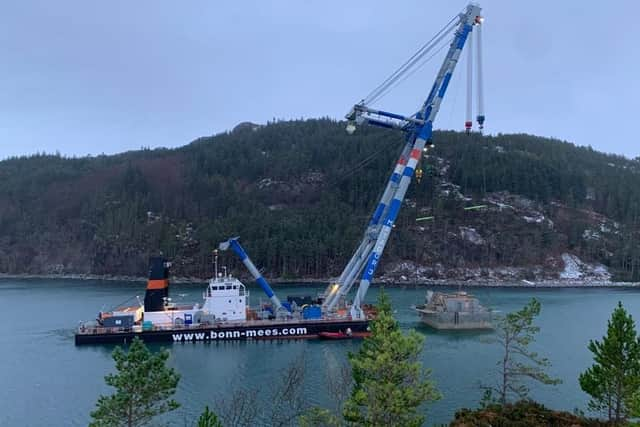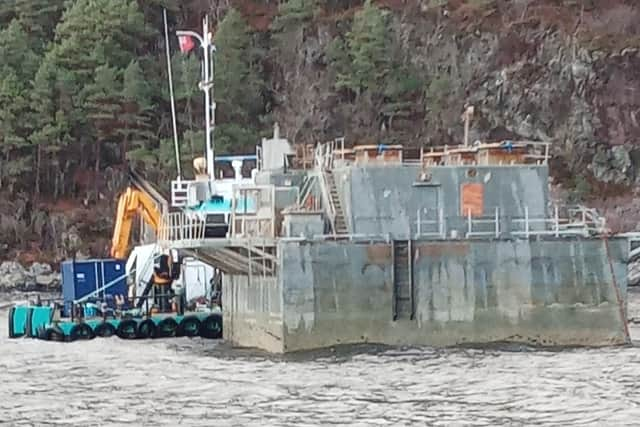Wrecked barge holding ‘toxic’ and potentially ‘explosive' gases is beached for decontamination operation in scenic Scottish Highland bay
The barge, which contained fish feed, sank at a fish farm owned by Faroese firm Bakkafrost at Portree, on the Isle of Skye, during Storm Arwen in November last year. Surveys of the sunken barge showed it contained gases that were “toxic in composition”, with hydrogen sulphide and methane detected, and in the “explosive range”.
A 500m exclusion zone was placed around the area. The wreck lay on the seabed until earlier this month, when it was raised so it could be emptied of 690 tonnes of waste water and feed and taken for repair or scrap.
Advertisement
Hide AdAdvertisement
Hide AdThe vessel has in recent days been towed from Portree by a giant floating crane, sitting at anchor in various spots around Loch Carron.
It has now been beached at Reraig Bay – across the water from the well-known village of Plockton and on the edge of the Loch Carron marine protected area, which is home to rare flame shell beds – to allow the remaining contents to be removed and transported to Aberdeenshire for disposal.
Alternative options, such as docking at the nearby Kishorn yard or anchoring at sea, were considered too hazardous by the salvage team.
Bakkafrost has been liaising with officials from the Scottish Environment Protection Agency, Police Scotland, Marine Scotland, Public Health Scotland, NHS Highland, Crown Estate Scotland, Highland Council, the Scottish Fire and Rescue Service, and the Maritime and Coastguard Agency over the salvage operation, according to documents released under Freedom of Information rules. However, local communities have been kept in the dark.
Local resident Lou-Lou Troup, who owns one of the two houses in Reraig, is concerned over the possibility of an environmental disaster.


“I am absolutely horrified that this stinky fish barge has been dumped in Reraig Bay, a beautiful place where people come to walk their dogs and collect local shellfish such as whelks and mussels,” she said. “It is about 150 yards from our house. It’s hideous and I’m worried about the danger of contamination if anything goes wrong or the weather is very bad.
“And we don’t even know if the stuff inside is poisonous. We have been told nothing.”
Duncan McAndrew, a creel boat skipper who works out of Plockton and spokesperson for the North West Responsible Fishermen's Association, said the crane, Matador3, had been moored for a time alongside one of his fishing sites.
Advertisement
Hide AdAdvertisement
Hide AdWhen passing the craft he could smell a strong and unpleasant odour and could see workers aboard wearing gas masks.


“Local fishermen were aware that the barge was to be raised, but were not informed of any issues regarding safety,” he said. “For the Matador3, with feed barge attached, to turn up in Loch Carron unannounced and without any appropriate safeguards being put in place is both unacceptable and deeply concerning.
“From VHF radio chatter, there didn't appear to be a clear plan of action as to what to do, which begs the question why was the barge anywhere near active fishing vessels without appropriate safeguards in place and also so close to the village of Plockton?
“The Matador3 was at anchor within 100m of creel fleets for six days. What harm might I have come to by breathing in the foul stench coming from the barge?
“Equally, what harms could have been done to fishing grounds or adjacent flame shell beds in the marine protected area? If there were concerns over the toxicity of the feed barge, surely fishermen and residents of Plockton and the surrounding area should not have been put at risk.”


Don Staniford, director of protest group $camon $cotland, has been tracking the feed barge and other vessels involved in the recovery operation. He is calling for a ban on fish farms in Scotland.
“Salmon farming in Scotland is a toxic time-bomb,” he said. “The spread of environmental pollution from salmon farms littering the Highlands and Islands now extends to feed barges leaking contaminated water and feed.”
Bakkafrost has been approached for comment.
Comments
Want to join the conversation? Please or to comment on this article.